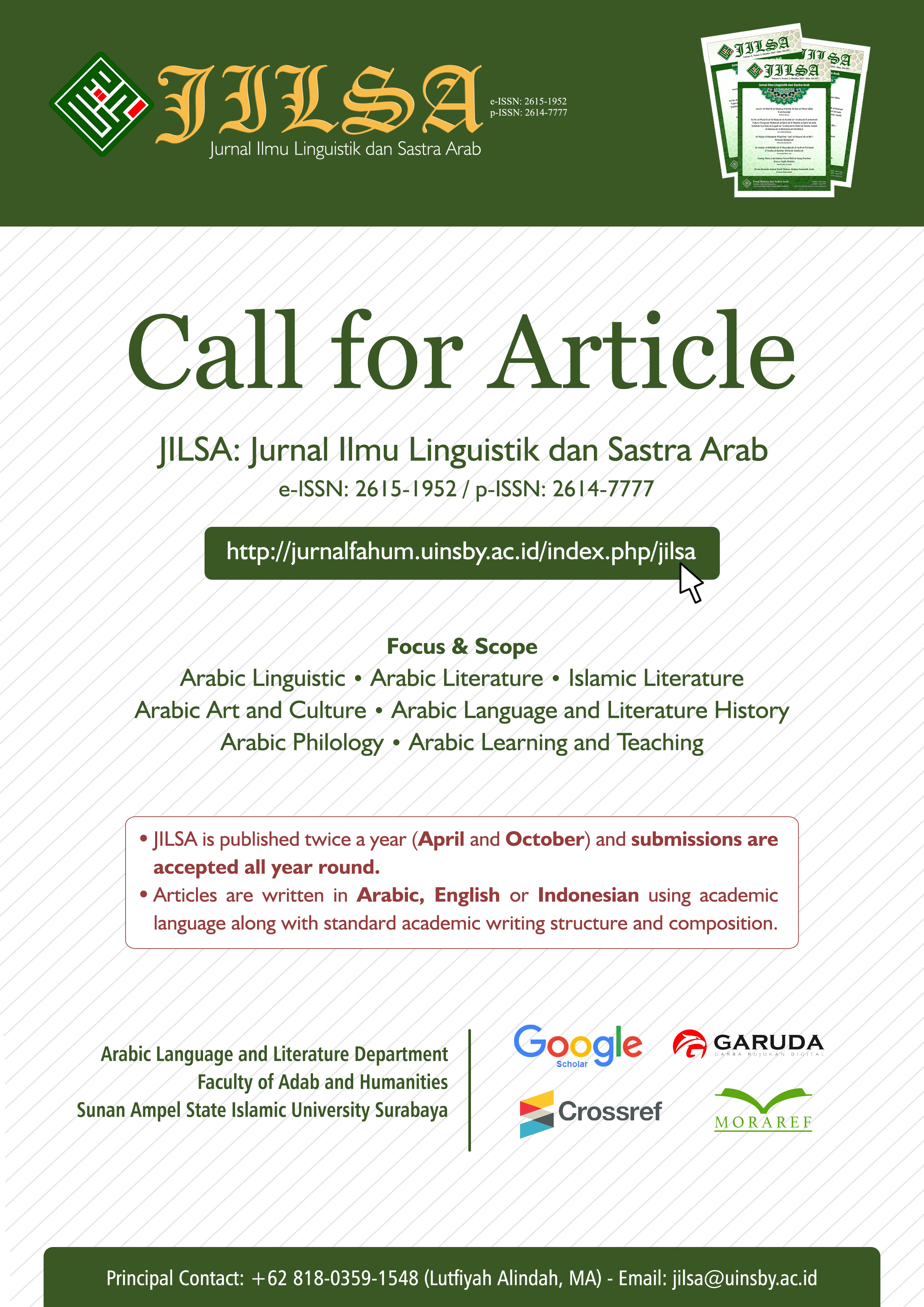Arabic Code As Ethnic Identity on Multilingualism Society in Kampong Arab Ampel Surabaya
DOI:
https://doi.org/10.15642/jilsa.2022.6.1.1-9Keywords:
Arabic code, ethnic identity, fushah, 'amiyahAbstract
The emergence of Muslim immigrants’ centuries ago, to be specific Arab-Hadrami descendants and it networks, plays significant role to express Islamic practices. The practices of Hadrami descendant in kampong (hamlet) Arab Surabaya closely related to their respect toward local inhabitants. It is usually expressed through their language and its manners. Besides, their interaction with local people imposes them to switch speaking in Indonesian, Javanese, and Maduranese. They used two languages (bilingualism) or more (multilingualism) in an everyday conversation. Interestingly, they attempt to practice and maintain Arabic to show their identity as holy people relate to their claim that they trace their descent to the Prophet Muhammad. The objective of research is describing relationship between language and culture that implicates into daily language practices in Arab community, particularly in kampong Arab Ampel Surabaya. The researcher uses archival or documentary method to search the various languages and ethnography method to describe and explore daily language of native. This paper reveals that the daily practices of Arabic code emphasize their identity individually or socially and defend their language in social multilingualism. In addition, fushah language or high level of Arabic language is used only in formal situation. However, most of them is using low level of Arabic language called ‘Amiyah in non formal situation both in public or private sphere.
Downloads
References
Berg, Van den L. W. C. (1989). Orang Arab Nusantara. Depok: INIS.
Bloom, J. P. dan Gumperz. (1972). “Social Meaning in Linguistic Structure: Code Switchimg in Norway”, dalam Gumperz dan Hymes 407-434.
Duranti, Allessandro. (1997). Linguistic Anthropologi. Cambridge: Cambridge University Press.
Fasold, Ralph. (1984). The Sociolinguistics of Society. Oxford: Basil Blackwell.
Fishman, Joshua A. (1964). Reading In Sociology Of Language. New York: Yeshiva University.
Hodges, Robert and Guther Kress. (1991). Social Semiotics. Cambridge: Polity Press.
Mahsun, M.S. (2005). Metode Penelitian Bahasa Tahapan Strategi, Metode, dan Tekniknya. Jakarta; Rajawali Press.
Nababan, P.W.J. (1984). Sosiolinguistik: Suatu Pengantar. Jakarta: Gramedia.
Patji, Abdul Rachman.(1983). “Asimilasi Golongan Etnis Arab: Suatu Studi Lapangan di Kelurahan Ampel Surabaya” dalam Masyarakat Indonesaia: Majalah Ilmu-Ilmu Sosial Indonesia, No. 1, Jilid X, Juni.
Ricklef, M.C. (1991). Sejarah Indonesia Modern. Yogyakarta: Gadjah Mada Press,
Romaine, Suzanne. (1995). Bilingualism. Massachusette: Blackwell.
Sudaryanto. (1993). Metode dan Aneka Teknik Analisis Bahasa-Pengantar Penelitian Wahana Kebudayaan secara Linguistis. Yogyakarta: Duta Wacana University Press.
Sumarsono dan Paina. 2004. Sosiolinguistik. Yogyakarta: Pustaka Pelajar.
Suwito. (1997). Sosiolinguistik. Surakarta: Fakultas Sastra UNS.
Thomas, Linda & Shan Wareing. (2007). Language, Societ and Power (terj). Yogyakarta: Pustaka Pelajar.
Wierzbicka, Anna. (1996). Cross-Cultural Communication. Melbourne: The Third Austalian`Linguistic Institute
Downloads
Published
How to Cite
Issue
Section
License
Copyright (c) 2022 JILSA (Jurnal Ilmu Linguistik dan Sastra Arab)

This work is licensed under a Creative Commons Attribution-ShareAlike 4.0 International License.














